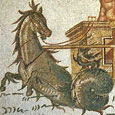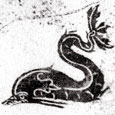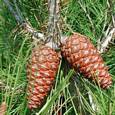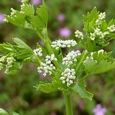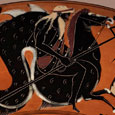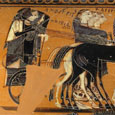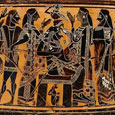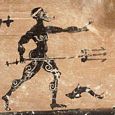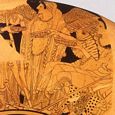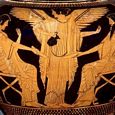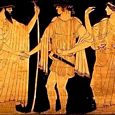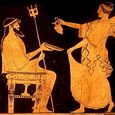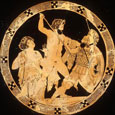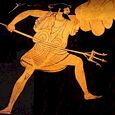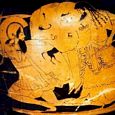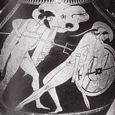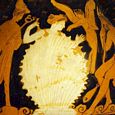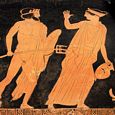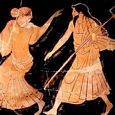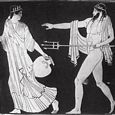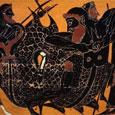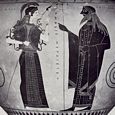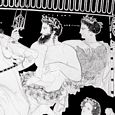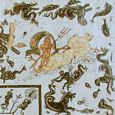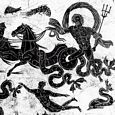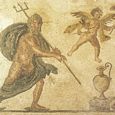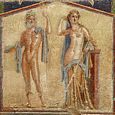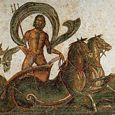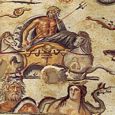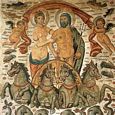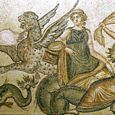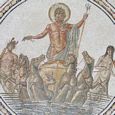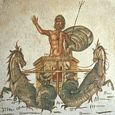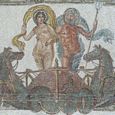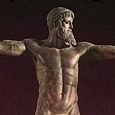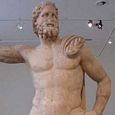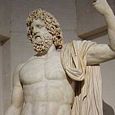POSEIDON
Greek Name
Ποσειδων
Transliteration
Poseidôn
Latin Spelling
Poseidon
Translation
Neptunus, Neptune
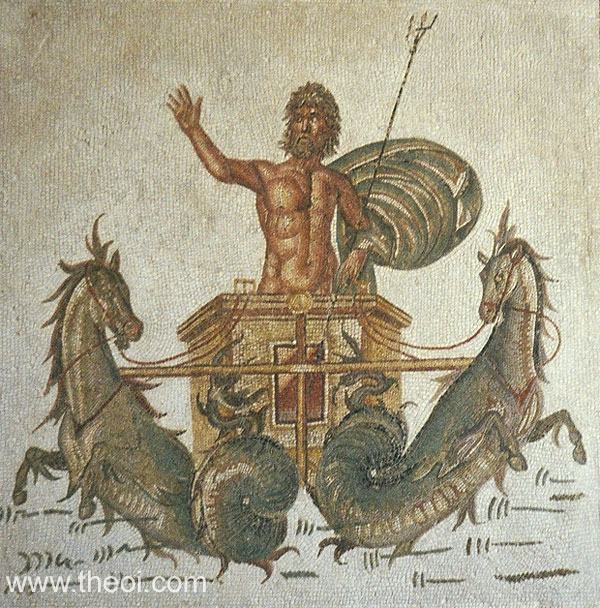
POSEIDON was the Olympian god of the sea, earthquakes, floods, drought and horses.
He was depicted as a mature man with a sturdy build and dark beard holding a trident (a three-pronged
fisherman's spear).
MYTHS
At birth Poseidon was swallowed whole by his father Kronos (Cronus), but Zeus later enlisted the aid of the goddess Metis who fed the Titan a magical elixir causing him to disgorge the god. <<More>>
During the War of the Titanes, the Kyklopes (Cyclopes) crafted a magical trident for Poseidon, and together with his brothers Zeus and Haides he defeated the elder gods and imprisoned them in Tartaros. <<More>>
Poseidon and his brothers drew lots for the division of the cosmos after the fall of the Titanes, and won the sea as his domain.
When the Gigantes (Giants) besieged the gods of Olympos, Poseidon crushed Polybotes beneath the island of Kos (Cos). <<More>>
He entered a contest with the goddess Athena for dominion over Athens and produced the very first horse as a gift. But the king refused him the prize and in anger Poseidon afflicted the land with drought.
The god assaulted his sister Demeter in the shape of a horse as she was wandering the earth in search of her daughter Persephone. <<More>>
Poseidon seduced many nymphs and mortal woman often in the guise of an animal or flowing water. Some of his most famous conquests were the Gorgon Medousa (Medusa), Tyro, Amymone, and Aithra mother of the hero Theseus. <<More>>
The god helped build the walls of the city of Troy, but when King Laomedon refused the payment he had promised, Poseidon sent a sea-monster to ravage the land. <<More>>
The hero Odysseus blinded the god's son Polyphemos on his return from Troy and Poseidon sent a storm to scatter and wreck the hero's fleet. <<More>>
Many other myths are detailed over the following pages.
SYMBOLS & ATTRIBUTES
Poseidon's most distinctive attribute was the trident, a three-pronged fishing spear. He sometimes also wielded a boulder encrusted with sea creatures (crayfish, octopi, fish, etc.). The god was either clothed in a robe (chiton) and cloak (himation) or depicted nude with just a cloak draped loosely about his arms and shoulders. He was often crowned with a wreath of wild celery or a simple headband.
Below are some examples of his attributes as depicted in ancient Greek art:-
1. Trident & boulder; 2. Trident's head; 3. Boulder with sea creatures;
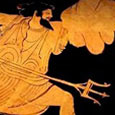
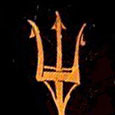
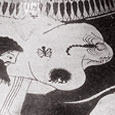
4. Headband; 5. Wreath of celery-leaves; 6. Billowing cloak.
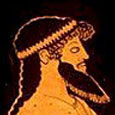
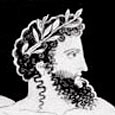
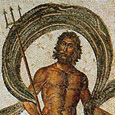
SACRED ANIMALS & PLANTS
Poseidon's sacred animals were the bull, the horse and the dolphin. As god of the sea he was also closely
associated with fish and other marine creatures. His chariot was drawn by a pair of fish-tailed horses (Greek:
hippokampoi). The most famous of his sacred animals in myth was the Cretan Bull, sire of the
Minotaur.
Poseidon's sacred plants were the pine tree and wild celery which were used to crown victors at the god's
Isthmian Games.
Below are examples of the god's animals as depicted in ancient Greek art and photos of his sacred plants:-
1. Hippocamp (half-horse, half-fish); 2. Dolphin; 3. Pine tree; 4. Wild celery.
POSEIDON PAGES ON THEOI.COM
This site contains a total of 6 pages describing the god, including general descriptions, mythology, and cult. The content is outlined in the Index of Poseidon Pages (left column or below).
FAMILY OF POSEIDON
PARENTS
KRONOS & RHEA (Homer Iliad 15.187, Hesiod Theogony 453, Apollodorus 1.4, Diodorus Siculus 5.68.1, et al)
OFFSPRING
Poseidon was a son of the Titans Kronos (Cronus) and Rheia and a grandson of Ouranos (the Heavens) and Gaia
(the Earth). He was a brother of the gods Zeus, Haides, Hera, Demeter and Hestia.
Poseidon married the marine-goddess Amphitrite, eldest child of Nereus, first born son of Pontos (the Sea), a
marital alliance which secured his dominion over the sea. Their son was the fish-tailed god Triton.
He also had numerous mortal offspring including giants such as Antaios and the cyclops Polyphemos, magical
horses like Pegasos and Arion, and various human kings, heroes and villians including Theseus and
Bellerophontes. <<More>>
Below are two graphics depicting Poseidon's family tree, the first with names transliterated from the Greek and the second with the common English spellings:-


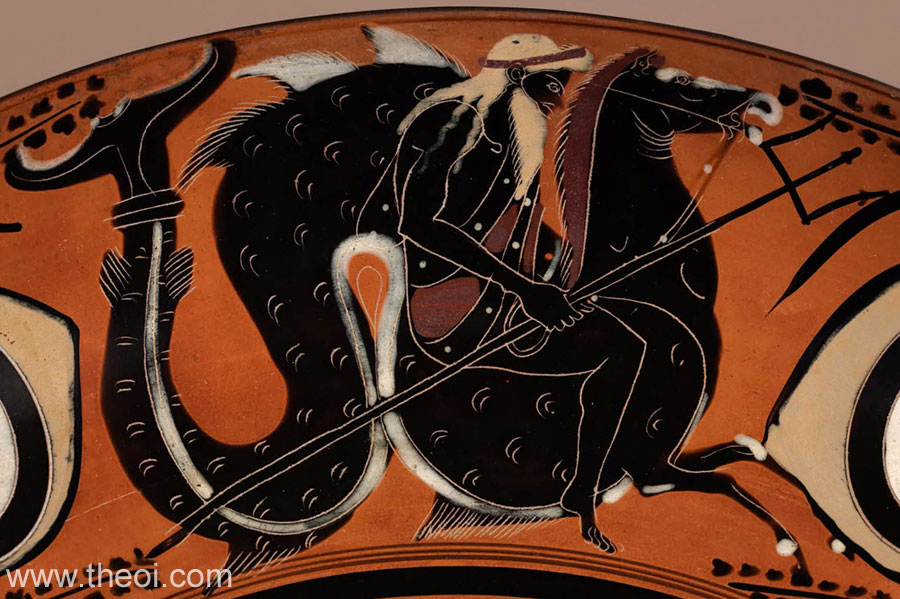
ENCYCLOPEDIA
POSEIDON (Poseidôn), the god of the Mediterranean sea. His name seems to be connected with potos, pontos and potamos, according to which he is the god of the fluid element. (Müller, Proleg. p. 290.)
He was a son of Cronos and Rhea (whence he is called Kronios and by Latin poets Saturnius, Pind. Ol. vi. 48; Virg. Aen. v. 799.) He was accordingly a brother of Zeus, Hades, Hera, Hestia and Demeter, and it was determined by lot that he should rule over the sea. (Hom. Il. xiv. 156, xv. 187, &c.; Hes. Theog, 456.) Like his brothers and sisters, he was, after his birth, swallowed by his father Cronos, but thrown up again. (Apollod. i. 1. § 5, 2. § 1.)
According to others, he was concealed by Rhea, after his birth, among a flock of lambs, and his mother pretended to have given birth to a young horse, which she gave to Cronos to devour. A well in the neighbourhood of Mantineia, where this is said to have happened, was believed, from this circumstance, to have derived the name of the "Lamb's Well," or Arne. (Paus. viii. 8. § 2.) According to Tzetzes (ad Lycoph. 644) the nurse of Poseidon bore the name of Arne; when Cronos searched after his son, Arne is said to have declared that she knew not where he was, and from her the town of Arne was believed to have received its name. According to others, again, he was brought up by the Telchines at the request of Rhea. (Diod. v. 55.)
In the earliest poems, Poseidon is described as indeed equal to Zeus in dignity, but weaker. (Hom. Il. viii. 210, xv. 165, 186, 209; comp. xiii. 355, Od. xiii. 148.) Hence we find him angry when Zeus, by haughty words, attempts to intimidate him; nay, he even threatens his mightier brother, and once he conspired with Hera and Athena to put him into chains (Hom. Il. xv. 176, &c., 212, &c.; comp. i. 400.); but, on the other hand, we also find him yielding and submissive to Zeus (viii. 440).
The palace of Poseidon was in the depth of the sea near Aegae in Euboea (xiii. 21; Od. v. 381), where he kept his horses with brazen hoofs and golden manes. With these horses he rides in a chariot over the waves of the sea, which become smooth as he approaches, and the monsters of the deep recognise him and play around his chariot. (Il. xiii. 27, comp. Virg. Aen. v. 817, &c., i. 147; Apollon. Rhod. iii. 1240, &c.) Generally he himself put his horses to his chariot, but sometimes he was assisted by Amphitrite. (Apollon. Rhod. i. 1158, iv. 1325; Eurip. Androm. 1011; Virg. Aen. v. 817.) But although he generally dwelt in the sea, still he also appears in Olympus in the assembly of the gods. (Hom. II. viii. 440, xiii. 44, 352, xv. 161, 190, xx. 13.)
Poseidon in conjunction with Apollo is said to have built the walls of Troy for Laomedon (vii. 452; Eurip. Androm. 1014),whence Troy is called Neptunia Pergama (Neptunus and Poseidon being identified, Ov. Fast. i. 525, Heroid. iii. 151; comp. Virg. Aen. vi. 810.) Accordingly, although he was otherwise well disposed towards the Greeks, yet he was jealous of the wall which the Greeks built around their own ships, and he lamented the inglorious manner in which the walls erected by himself fell by the hands of the Greeks. (Hom. Il. xii. 17, 28, &c.) When Poseidon and Apollo had built the walls of Troy, Laomedon refused to give them the reward which had been stipulated, and even dismissed them with threats (xxi. 443); but Poseidon sent a marine monster, which was on the point of devouring Laomedon's daughter, when it was killed by Heracles. ii. 5 § 9.)
For this reason Poseidon like Hera bore an implacable hatred against the Trojans, from which not even Aeneas was excepted (Hom. Il. xx. 293, &c.; comp. Virg. Aen. v. 810; Il. xxi. 459, xxiv. 26, xx. 312, &c.), and took an active part in the war against Troy, in which he sided with the Greeks, sometimes witnessing the contest as a spectator from the heights of Thrace, and sometimes interfering in person, assuming the appearance of a mortal hero and encouraging the Greeks, while Zeus favoured the Trojans. (Il. xiii. 12, &c., 44, &c., 209, 351, 357, 677, xiv. 136, 510.) When Zeus permitted the gods to assist whichever party they pleased, Poseidon joining the Greeks, took part in the war, and caused the earth to tremble; he was opposed by Apollo, who, however, did not like to fight against his uncle. (Il. xx. 23, 34, 57, 67, xxi. 436, &c.) In the Odyssey, Poseidon appears hostile to Odysseus, whom he prevents from returning home in consequence of his having blinded Polyphemus, a son of Poseidon by the nymph Thoosa. (Hom. Od. i. 20, 68, v. 286, &c., 366, &c., 423, xi. 101, &e., xiii. 125; Ov. Trist. i. 2. 9.)
Being the ruler of the sea (the Mediterranean), he is described as gathering clouds and calling forth storms, but at the same he has it in his power to grant a successful voyage and save those who are in danger, and all other marine divinities are subject to him. As the sea surrounds and holds the earth, he himself is described as the god who holds the earth (gaiêochos), and who has it in his power to shake the earth (enosichthôn, kinêtêr gas).
He was further regarded as the creator of the horse, and was accordingly believed to have taught men the art of managing horses by the bridle, and to have been the originator and protector of horse races. (Hom. Il. xxiii. 307, 584; Pind. Pyth. vi.50 ; Soph. Oed. Col. 712, &c.) Hence he was also represented on horseback, or riding in a chariot drawn by two or four horses, and is designated by the epithets hippios, hippeios, or hippios anax. (Paus. i. 30. § 4, viii. 25. § 5, vi. 20. § 8, viii. 37. § 7 ; Eurip. Phoen. 1707; comp. Liv. i. 9, where he is called equester.) In consequence of his connection with the horse, he was regarded as the friend of charioteers (Pind. Ol. i. 63, &c.; Tzetz. ad Lyc. 156), and he even metamorphosed himself into a horse, for the purpose of deceiving Demeter.
The common tradition about Poseidon creating the horse is as follows:-- when Poseidon and Athena disputed as to which of them should give the name to the capital of Attica, the gods decided, that it should receive its name from him who should bestow upon man the most useful gift. Poseidon their created the horse, and Athena called forth the olive tree, for which the honour was conferred upon her. (Serv. ad Virg. Georg. i. 12.) According to others, however, Poseidon did not create the horse in Attica, but in Thessaly, where he also gave the famous horses to Peleus. (Lucan, Phars. vi. 396, &c.; Hom. Il. xxiii. 277; Apollod. iii. 13. § 5.)
The symbol of Poseidon's power was the trident, or a spear with three points, with which he used to shatter rocks, to call forth or subdue storms, to shake the earth, and the like. Herodotus (ii. 50, iv. 188) states, that the name and worship of Poseidon was imported to the Greeks from Libya, but he was probably a divinity of Pelasgian origin, and originally a personification of the fertilising power of water, from which the transition to regarding him as the god of the sea was not difficult.
It is a remarkable circumstance that in the legends about this divinity there are many in which he is said to have disputed the possession of certain countries with other gods. Thus, in order to take possession of Attica, he thrust his trident into the ground on the acropolis, where a well of sea-water was thereby called forth; but Athena created the olive tree, and the two divinities disputed, until the gods assigned Attica to Athena. Poseidon, indignant at this, caused the country to be inundated. (Herod. viii. 55; Apollod. iii. 14. § 1 ; Paus. i. 24. § 3, &c.; Hygin. Fab. 164.) With Athena he also disputed the possession of Troezene, and at the command of Zeus he shared the place with her. (Paus. ii. 30. § 6 ) With Helios he disputed the sovereignty of Corinth, which along with the isthmus was adjudged to him, while Helios received the acropolis. (ii. 1. § 6.) With Hera he disputed the possession of Argolis, which was adjudged to the former by Inachus, Cephissus, and Asterion, in consequence of which Poseidon caused the rivers of these river-gods to be dried up. (ii. 15. § 5, 22. § 5; Apollod. ii. 1. § 4.) With Zeus, lastly, he disputed the possession of Aegina, and with Dionysus that of Naxos. (Plut. Sympos. ix. 6.) At one time Delphi belonged to him in common with Ge, but Apollo gave him Calauria as a compensation for it. (Paus. ii. 33. § 2, x. 5. § 3; Apollon. Rhod. iii. 1243, with the Schol.)
The following legends also deserve to be mentioned. In conjunction with Zeus he fought against Cronos and the Titans (Apollod. i. 2. § 1), and in the contest with the Giants he pursued Polybotes across the sea as far as Cos, and there killed him by throwing the island upon him. (Apollod. i. 6. § 2; Paus. i. 2. § 4.) He further crushed the Centaurs when they were pursued by Heracles, under a mountain in Leucosia, the island of the Seirens. (Apollod. ii. 5. § 4.) He sued together with Zeus for the hand of Thetis, but he withdrew when Themis prophesied that the son of Thetis would be greater than his father. (Apollod. iii. 13. § 5; Tzetz. ad Lyc. 178.) When Ares had been caught in the wonderful net by Hephaestus, the latter set him free at the request of Poseidon (Hom. Od. viii. 344, &c.), but Poseidon afterwards brought a charge against Ares before the Areiopagus, for having killed his son Halirrhothius. (Apollod. iii. 14. § 2.) At the request of Minos, king of Crete, Poseidon caused a bull to rise from the sea, which the king promised to sacrifice; but when Minos treacherously concealed the animal among a herd of oxen, the god punished Minos by causing his daughter Pasiphaë to fall in love with the bull. (Apollod. iii. § 3, &c.) Periclymenus, who was either a son or a grandson of Poseidon, received from him the power of assuming various forms. (i. 9. § 9, iii. 6. § 8.)
Poseidon was married to Amphitrite, by whom he had three children, Triton, Rhode, and Benthesicyme (Hes. Theog. 930; Apollod. i. 4. § 6, iii. 15. § 4); but he had besides a vast number of children by other divinities and mortal women.
He is mentioned by a variety of surnames, either in allusion to the many legends related about him, or to his nature as the god of the sea. His worship extended over all Greece and southern Italy, but he was more especially revered in Peloponnesus (which is hence called oikêtêrion Poseidônos) and in the Ionic coast towns. The sacrifices offered to him generally consisted of black and white bulls (Hom. Od. iii. 6, Il. xx. 404; Pind. Ol. xiii. 98; Virg. Aen. v. 237); but wild boars and rams were also sacrificed to him. (Hom. Od. xi. 130, &c., xxiii. 277; Virg. Aen. iii. 119.) In Argolis bridled horses were thrown into the well Deine as a sacrifice to him (Paus. viii. 7. § 2), and horse and chariot races were held in his honour on the Corinthian isthmus. (Pind. Nem. v. 66, &c.) The Panionia, or the festival of all the Ionians near Mycale, was celebrated in honour of Poseidon. (Herod. i. 148.)
In works of art, Poseidon may be easily recognised by his attributes, the dolphin, the horse, or the trident (Paus. x. 36. § 4), and he was frequently represented in groups along with Amphitrite, Tritons, Nereids, dolphins, the Dioscuri, Palaemon, Pegasus, Bellerophontes, Thalassa, Ino, and Galene. (Paus. ii. 1. § 7.) His figure does not present the majestic calm which characterises his brother Zeus; but as the state of the sea is varying, so also is the god represented sometimes in violent agitation, and sometimes in a state of repose. It must be observed that the Romans identified Poseidon with their own Neptunus, and that accordingly the attributes belonging to the former are constantly transferred by the Latin poets to the latter.
Source: Dictionary of Greek and Roman Biography and Mythology.
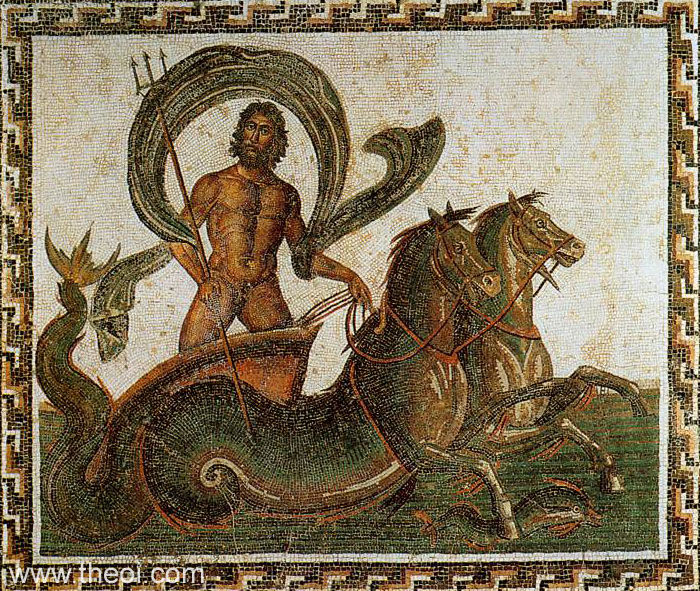
CLASSICAL LITERATURE QUOTES
HYMNS TO POSEIDON
I) THE HOMERIC HYMNS
Homeric Hymn 22 to Poseidon (trans. Evelyn-White) (Greek epic C7th or 6th B.C.)
:
"I begin to sing about Poseidon, the great god, mover of the earth and fruitless sea, god of the deep who
is also lord of Helikon (Helicon) and wide Aigai (Aegae). O Shaker of the Earth (Ennosigaios), to be a
tamer of horses and a saviour of ships! Hail Poseidon Holder of the Earth (gaienokhos), dark-haired
lord! O blessed one, be kindly in heart and help those who voyage in ships!"
II) THE ORPHIC HYMNS
Orphic Hymn 17 to Poseidon (trans. Taylor) (Greek hymns C3rd B.C. to 2nd A.D.)
:
"Hear, Poseidon, ruler of the sea profound, whose liquid grasp begirds the solid ground; who, at the bottom
of the stormy main, dark and deep-bosomed holdest they watery reign. Thy awful hand the brazen trident bears,
and sea's utmost bound thy will reveres. Thee I invoke, whose steeds the foam divide, from whose dark locks the
briny waters glide; shoe voice, loud sounding through the roaring deep, drives all its billows in a raging heap;
when fiercely riding through the boiling sea, thy hoarse command the trembling waves obey. Earth-shaking,
dark-haired God, the liquid plains, the third division, fate to thee ordains. 'Tis thine, cerulean daimon, to
survey, well-pleased, the monsters of the ocean play. Confirm earth's basis, and with prosperous gales waft
ships along, and swell the spacious sails; add gentle peace, and fair-haired health beside, and pour abundance
in a blameless tide."
III) OTHER HYMNS
Aelian, On Animals 12. 45 (trans. Schofield) (Greek natural history C2nd to 3rd A.D.)
:
"Arion [the poet rescued by a dolphin] wrote a hymn of thanks to Poseidon that bears witness to the
dolphin's love of music and is a kind of payment of the reward due to them also for having saved his life. This
is the hymn : ‘Highest of the gods, lord of the sea, Poseidon of the golden trident, earth-shaker in the
swelling brine, around thee the finny monsters (theres) in a ring swim and dance, with nimble flingings
of their feet leaping lightly, snub-nosed hounds with bristling neck, swift runners, music-loving dolphins,
sea-nurslings of the Nereis (Nereid) maids divine, whom Amphitrite bore, even they that carried me, a wanderer
on the Sikelian (Sicilian) main, to the headland of Tainarion (Taenarum) in Pelops' land, mounting me upon their
humped backs as they clove the furrow of Nereus' plain, a path untrodden, when deceitful men had cast me from
their sea-faring hollow ship in to the purple swell of sea.’"
ANCIENT GREEK & ROMAN ART
SOURCES (ALL POSEIDON PAGES)
GREEK
- Homer, The Iliad - Greek Epic C8th B.C.
- Homer, The Odyssey - Greek Epic C8th B.C.
- Hesiod, Theogony - Greek Epic C8th - 7th B.C.
- Hesiod, Catalogues of Women Fragments - Greek Epic C8th - 7th B.C.
- Hesiod, Astronomy Fragments - Greek Epic C8th - 7th B.C.
- The Homeric Hymns - Greek Epic C8th - 4th B.C.
- Epic Cycle, The Cypria Fragments - Greek Epic C7th - 6th B.C.
- Pindar, Odes - Greek Lyric C5th B.C.
- Greek Lyric IV Bacchylides, Fragments - Greek Lyric C5th B.C.
- Greek Lyric IV Corinna, Fragments - Greek Lyric C5th B.C.
- Herodotus, Histories - Greek History C5th B.C.
- Plato, Republic - Greek Philosophy C4th B.C.
- Apollodorus, The Library - Greek Mythography C2nd A.D.
- Apollonius Rhodius, The Argonautica - Greek Epic C3rd B.C.
- Callimachus, Hymns - Greek Poetry C3rd B.C.
- Callimachus, Fragments - Greek Poetry C3rd B.C.
- Lycophron, Alexandra - Greek Poetry C3rd B.C.
- Diodorus Siculus, The Library of History - Greek History C1st B.C.
- Strabo, Geography - Greek Geography C1st B.C. - C1st A.D.
- Pausanias, Description of Greece - Greek Travelogue C2nd A.D.
- Plutarch, Moralia - Greek Historian C1st - 2nd A.D.
- The Orphic Hymns - Greek Hymns C3rd B.C. - C2nd A.D.
- Aelian, On Animals - Greek Natural History C2nd - 3rd A.D.
- Aelian, Historical Miscellany - Greek Rhetoric C2nd - 3rd A.D.
- Athenaeus, Deipnosophistae - Greek Rhetoric C3rd A.D.
- Philostratus the Elder, Imagines - Greek Rhetoric C3rd A.D.
- Ptolemy Hephaestion, New History - Greek Mythography C1st - 2nd A.D.
- Oppian, Halieutica - Greek Poetry C3rd A.D.
- Nonnus, Dionysiaca - Greek Epic C5th A.D.
ROMAN
- Hyginus, Fabulae - Latin Mythography C2nd A.D.
- Hyginus, Astronomica - Latin Mythography C2nd A.D.
- Ovid, Metamorphoses - Latin Epic C1st B.C. - C1st A.D.
- Ovid, Heroides - Latin Poetry C1st B.C. - C1st A.D.
- Pliny the Elder, Natural History - Latin Encyclopedia C1st A.D.
BYZANTINE
- Photius, Myriobiblon - Byzantine Greek Scholar C9th A.D.
- Suidas, The Suda - Byzantine Greek Lexicon C10th A.D.
OTHER SOURCES
Other sources not quoted here: numerous.
BIBLIOGRAPHY
A complete bibliography of the translations quoted on this page.
